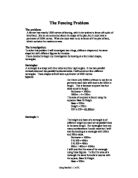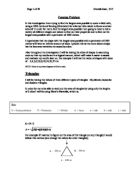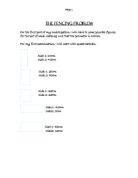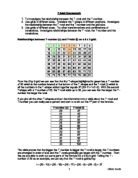Geography Investigation: Residential Areas
Residential Areas How do Basingstoke's residential areas change, improve and reflect different urban models? Applied Understanding For my geography coursework I am going to study the different types of residential areas throughout Basingstoke; working from the Central Business District and following the main route through Basingstoke in a south westerly direction. When my coursework is complete I am hoping to come up with a conclusion about whether Basingstoke follows the concentric model or if it fits more to the criteria of the sector model. The central place theory is a geographical theory that tries to explain the size and spacing of humans, however, this theory only works when certain criteria are met, which in reality, aren't met, for instance: an isotropic, limitless amount of space, an evenly distributed population, evenly distributed resources, consumers all have same purchasing power and no provider of goods can earn excess profit. The concentric ring model (also known as the Burgess Model) is slightly more realistic than the central place theory and is actually based on a city, Chicago, Illinois. The theory puts forward that a settlement grows evenly (see Figure 1 below) , with the CBD in the middle, then light manufacturing, working class housing, middle class housing and then on the outskirts of the settlement, the high-class housing. At this stage I can
Fencing problem.
Problem specification A farmer has exactly 1000 metres of fencing. With this 1000 meter of fencing she wishes to fence off a plot of level land. She is not concerned with the shape of the plot, but must have a perimeter of 1000 m. her requirements are that the fence off the plot of land should contain the maximum area. Plan At the beginning of this experiment I shall begin experimenting with the simplest of all shapes. Triangles shall be investigated first. These triangles shall include equilateral triangle, an isosceles triangle, a right-hand triangle and a scalene triangle. I would find the area and plot the results upon a table. After investigation triangles I shall start with the regular shapes with four sides, a square, rectangles, a trapezium, a parallelogram and a rhombus. Once again areas of these shapes shall be found and recorded on a table. Now I shall continue experimenting different shapes by increasing the number of sides of each shape. These will include: triangles, quadrilaterals, a pentagon, a hexagon, a heptagon, and octagon, a nonagon and a decagon. I would take the whole investigation one step further and experiment with polygons shapes such as letters. For example a polygon shaped as an H, a polygon shaped as an E, and so on. These areas shall also be found and recorded. Finally I shall scrutinize a circle. The results of the area shall also be
Regeneration has had a positive impact on the Sutton Harbour area - its environment, residents and visitors. Discuss
Regeneration has had a positive impact on the Sutton Harbour area - its environment, residents and visitors I am investigating this topic because, as a class, we have studied the inner city areas of MEDC's. We have looked at some of the problems and considered how regeneration may help to solve some of them. Today, about 70% of the UK's population live in the city. This can lead to many problems, such as overcrowding, an increase in health and sanitation problems and much competition between businesses within a city and also between different cities that are trying to attract potential investors into the city. Trying to create a balance between the essential and desirable things in a city is hard to achieve when trying to keep both the residents and the city council happy. This is a problem that the Sutton Harbour area has had to try and overcome by using regeneration to make the place more attractive to businesses and tourists to help the council have a higher income, but also to suit the current residents. I will look at just how successful the regeneration of Sutton Harbour has been and find out the views of the people that have to live their, and why tourists were attracted to the area. Key Concepts Definitions Urban decay A region or building in a built up area that is of a poorer quality and condition to that of the surrounding area. Inner city The older
The Fencing Problem
Yr 10 GCSE Maths Coursework: The Fencing Problem In this investigation I plan to explore various polygons and deduce which type would yield the greatest area while complying with a perimeter of 1000m. I am only investigating regular polygons, because the otherwise would prove to be far too complex and involve an immeasurable amount of data. I will expand on this decision later in the investigation. I intend to find a general formula for the area of any polygon and prove it by applying it to each polygon I explore. The polygons I plan to investigate include: * Triangle (Isosceles, Scalene and Equilateral) * Rectangle * Parallelogram * Pentagon * Hexagon * Octagon * Decagon * A polygon with 15 sides (Pentadecagon) * A polygon with 20 sides (Icosagon) * A polygon with n number of sides (N-Gon) * Circle As you can see, I am working my way up chronologically in aspects of the number of sides on each polygon. For each one I will produce a table of data displaying the progressive areas for the shape; the areas will increase/decrease respectively according to the varying unit (e.g. 50) used for each instance of the shape. For every polygon I will produce a line graph presenting their progressive areas from the table of data. I will indicate the highest value on the graph (i.e. the highest area for the shape) and evaluate it accordingly. The area formulas for each
The Fencing Problem
The Fencing Problem The problem: A farmer has exactly 1000 metres of fencing, with it she wishes to fence off a plot of level land. She is not concerned about the shape of the plot, but it must have a perimeter of 1000 metres. What she does wish to do is fence of f the plot of land, which contains the maximum area. The investigation: To solve this problem I will investigate two things, different shapes and the same shape but with different figures for its sides. I have decided to begin my investigation by looking at a four sided shapes, rectangles. Rectangles: A rectangle is a shape with four sides and four right angles. It has two parallel vertical sides and two parallel horizontal sides. I will construct four different rectangles. These shapes will all have a perimeter of 1000 metres. Square: As I have only 1000m of fence to use for its perimeter each side will need to be 250m in length. This is because a square has four sides equal in length. Perimeter = 1000m 1000m ( 4 = 250m The area of a square is found using the equation Base ( Height. Base = 250m Height = 250m 250 ( 250 = 62,500m² Rectangle 1: The height and base of a rectangle is of different height but each set of parallel lines is the same length. For rectangles there are many combinations I could make but I will start by looking at a rectangle with 300m and 200m sides. Perimeter = 1000m 2
Fencing Problem
Fencing Problem In this investigation I am trying to find the largest area possible to cover a field with, using a 1000 metres of fencing (Perimeter) for a farmer who wants to fence a certain area off. In order for me to find the largest area possible I am going to have to test a variety of different shapes and values to find out their properties and to find me the largest area possible with a perimeter of 1000 metres. I hypothesize that the shape with the largest area possible with a perimeter of 1000 metres will have an infinite amount of sides. I predict this as the more sides a shape has the less area restriction is caused by sides. Also throughout the investigation I will be testing the sides of shapes in ascending order so that my results are in a logical manner, which will make it easier to assess and evaluate my results later on. For example I will test the value of shapes with sides of - 3,4,5,6,7,8,9,10,14,22,57 etc NOTE - None of my drawn diagrams will be to scale. Triangles I will be testing the values of three different types of triangles -Equilateral, Isosceles and Scalene triangles. In order for me to be able to work out the area of triangles by using only the lengths of 3 sides I will be using Hero's Formula, which is; S = P / 2 A = S(S-a)(S-b)(S-c) For example if I wanted to figure out the area of this triangle (or any triangle) I would follow
The Canoe Race
The Canoe Race The Canoe Race A group of canoeists on holiday at the seaside decide to have a race offshore. They set up a triangular course using a buoy and two other floats, with the start and finish at the buoy. They have been told that the prevailing current flows parallel to the shore at a speed of about 2 ms-1. If the total course is to be 300 metres long investigate where they might place the other two floats. Problem: How does the layout of the floats effect the time taken to complete the race? I would like to investigate two different models one being a right-angled triangle and the other being isosceles triangle. When investigating the isosceles triangle, an equilateral triangle would be investigated because as the length of the isosceles triangle will all equal, it becomes an equilateral triangle. I would first of all investigate the right-angled triangle. Model 1: Right-Angled Triangle C A B PREVAILLING CURRENT AT A SPEED OF 2 MS-1 COASTLINE Figure 1: The shape of the course (model 1). The shape of the course is shown in figure 1. To simplify the problem I am assuming that the angle CAB is a right angle. Even though the lengths of B and C will change, angle CAB will always be a right angle. 'A' in figure 1is where the buoy is positioned, and thus it is the start and finish of the race. The race starts at point A, then it continues on to point B, then to
I have been given 3 tasks in this piece of work. These tasks are to help me find out/work out formulae for the patterns between the short, medium and long sides of Pythagorean triples.
G.C.S.E Maths Coursework Winter '99 By Sheryar Majid Introduction I have been given 3 tasks in this piece of work. These tasks are to help me find out/work out formulae for the patterns between the short, medium and long sides of Pythagorean triples. The formulae I work out will be based on this: If I have the short side can I work out the middle and long side? And If I have the middle side can I work out the short and long side? And If I have the long side can I work out the short and middle side? From these 3 things I have to try and work out the relationships between the 3 sides and the area and perimeter of the Pythagorean triangle. An example of the 3 sides and the area and perimeter is this: Number of triangle (nth term) Length of Shortest Side Length of Middle Side Length of Longest Side Perimeter Area 3 4 5 2 6 2 5 2 3 30 30 3 7 24 25 56 84 From this graph we can already see that the difference between middle side and long side is +1. Also you can see all triples satisfy the condition A2 + B2 = C2, this is because if it were not that than it would not satisfy the condition. I will talk about satisfying the condition later on but basically Pythagorean triples have to satisfy a condition to work. In the following pages I will do the 3 subtasks given to me and from this I will work out the formulae's. Everything I do
The Fencing Problem
The Fencing Problem For the first part of my investigation, I will have to some possible figures for the plot of land, making sure that the perimeter is 1000m. For my first examination, I will start with quadrilaterals. Side 1: 100m Side 2: 400m Side 1: 200m Side 2: 300m Side 1: 250m Side 2: 250m Side 1: 450m Side2: 50m Side 1: 350m Side2: 150m Side 1 Side 2 Area 00 m 400 m Side*side= 40000 m2 250 m 250 m Side*side= 62500 m2 300 m 200 m Side*side= 60000 m2 350 m 50 m Side*side= 52500 m2 450 m 50 m Side*side= 22500 m2 The graph and the table indicate that when the width and the height of a regular quadrilateral have the least difference, the Area is at its greatest. This statement is proven by the square. A square has all the sides the same, so the difference is at the smallest since it is at zero. The Area of the square is the greatest, and this leads me to believe that regular shapes- i.e. shapes that have equal sides, have the biggest Area. I will test this prediction out on triangles. I will start with the most regular triangle - the equilateral, and then test a number of isosceles triangles. If my prediction is true then the equilateral triangle will have the biggest Area. Side 1, 2,3= 333.333 Sin (60)= x/333.33 X=288.66 (height) Area= ( X base X height =48112.52m2 Side 2, 3=450m Base= 100m 150m2 +x2= 350m2 x=316.23m
t shape t toal
T-total Coursework . To investigate the relationship between the T-total and the T-number. 2. Use grids of different sizes. Translate the T-shape to different positions. Investigate the relationship between the T-total and the T-number and the grid size. 3. Use grids of different sizes. Try other transformations and combinations of translations. Investigate relationships between the T-total, the T-number and the translations. Relationships between T-number (x) and T-total (t) on a 9 x 9 grid. 2 3 4 5 6 7 8 9 0 1 2 3 4 5 6 7 8 9 20 21 22 23 24 25 26 27 28 29 30 31 32 33 34 35 36 37 38 39 40 41 42 43 44 45 46 47 48 49 50 51 52 53 54 55 56 57 58 59 60 61 62 63 64 65 66 67 68 69 70 71 72 73 74 75 76 77 78 79 80 81 From the 9 by 9 grid we can see that the first T-shape highlighted in green has a T-number of 20 which is the number located at the bottom of the T-shape and the T-total (t) which is all the numbers in the T-shape added together equals 37 (20+11+1+2+3). With the second T-shape with a T-number of 23, the T-total adds up to 52, you can see that the larger the T-number the larger the total. If you plot all the other T-shapes and put the information into a table about the T-total and T-number you can really see a pattern and start to work out the 1st part of the formula. T-number (x)











